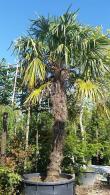Get Additional 5% Off 1st Order
Butia Capitata - the Pindo Palm



1. Add items to basket
2. Go to the basket
3. Enter your postcode in Delivery Price Check
Trunk height: 30-40 cm
Pot size: 70 Litres
Plant ID: 12161 64
click to view this plant size >Trunk height: 30-40 cm
Pot size: 110 Litres
Plant ID: 710 C 42
click to view this plant size >LIMITED STOCK only 1 available
- then no more stock of this size
Trunk height: 20-30 cm
Pot size: 180 Litres
Plant ID: 12158 C 42
click to view this plant size >LIMITED STOCK only 2 available
- then no more stock of this size
Pot size: 250 Litres
Plant ID: 10437 64
click to view this plant size >Trunk height: 60-70 cm
Pot size: 230 Litres
Plant ID: 5037 C 42
click to view this plant size >LIMITED STOCK only 1 available
- then no more stock of this size
Trunk height: 80-90 cm
Pot size: 500 Litres
Plant ID: 5039 64
click to view this plant size >To check delivery cost add your plants to basket, then you can type your postcode in our Quick Delivery Price Check.

Butia Capitata is commonly known as the Pindo Palm or Jelly Palm Tree. It is one of the hardiest of the feather palm trees. Graceful silvery-blue feather like leaves arch outwards. For best results grow in well-draining soil in well-sheltered gardens near larger trees for protection. A native of South America, specifically Argentina, Brazil and Uruguay. Butia's also suit container growing well, as the root system adapts to a confined growing space.
Butia Capitata has received the RHS Award of Garden Merit for its suitability for UK gardens. As it grows, its bulbous trunk will be topped by a particularly symmetrical crown, creating a graceful display with its evergreen foliage. If the summer is hot, the Jelly Palm tree will produce large fruits similar to apricots which are excellent for making jams and jellies.
Hardy to -10C, it will survive outdoors in southern regions or in sheltered locations as far north as London. In regions where winter temperatures fall below -10C, it can be wrapped in fleece to protect the growing point. It will grow to a mature height of 4-5 metres and spread of 3 metres. Little pruning is required, but in early spring outer fronds which have been damaged or turned brown should be cut back to the base with a pruning saw.
Plant your Pindo Palm in rich, well-drained soil in a sheltered spot with full sun and a south-facing aspect. It should be fed regularly through the growing season with a liquid fertilizer, and watered on a regular basis. It will not tolerate waterlogged soil, especially through the winter months. Tolerant of both salt and pollution, it is a good choice for urban and coastal gardens.
Butia Capitata is very happy growing in a container, making it an excellent choice for patios or rooftop terraces. It would be well-suited to a sheltered sunny corner in a courtyard, where its evergreen foliage would provide year-round interest.
The hardiness and graceful appearance of Butia Capitata make it an ideal palm for UK gardens; we have them available in various sizes.
Read our blog for more information on palms and many other plants.
















